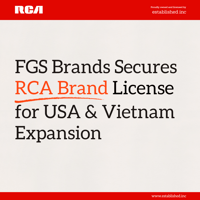Joint Venture Acquires Ownership Stakes in Four Women's Lifestyle Brands established.inc, a premier...
Reviving High End Heritage in Consumer Electronics: Why Licensing Inactive Brands Matters and How to Turn It Into a Profitable Play
A Playbook for Licensees, with Acoustic Research as a Case Study
 Licensing inactive consumer electronics brands with high-end recognition is like constructing an extraordinary building:
Licensing inactive consumer electronics brands with high-end recognition is like constructing an extraordinary building:
The heritage brand is the solid foundation, the base that gives character and credibility. On its own, the old structure might be overlooked, dismissed as outdated.
A new building alone might be functional but unremarkable. But when you combine the strength of the heritage foundation with the ambition of a modern build, you create something remarkable, unique, striking, and impossible to ignore.
The case of Acoustic Research illustrates this potential. Once a pioneer in high-fidelity sound, AR shows how a dormant brand, if revived with authenticity, discipline, and a phased commercial roadmap, can once again become a premium force in the market. Its heritage provides credibility, its absence offers a clean slate, and its story enables differentiation.
For licensees, AR is a template: a reminder that the next big commercial win may come not from inventing a new brand, but from intelligently reviving one that consumers already trust. With careful execution, history does not just repeat itself; it pays off.
Content:
1. Building on Heritage
2. The Equity of High-End Recognition
3. Beyond Retro: Positioning for Modern Consumers
4. Beyond Consumer: The Commercial Audio Opportunity
5. Commercial Value Drivers
6. Market Trends Supporting Revivals
7. Case Example: Acoustic Research
8. A Possible 3-Year Roadmap for Reviving Acoustic Research: From Dormancy to Commercial Payoff
9. Why AR Is a Special Licensing Opportunity
10. Conclusion
11. The Foundation Is Set — Let’s Begin
1. Building on Heritage
The consumer electronics industry has a history of celebrated names that once stood for prestige, innovation, and design leadership, only to vanish from the market. Some of these brands commanded deep respect in their prime: they represented cutting-edge audio systems, premium televisions, or high-fidelity components. Today, many of them sit dormant, neither active as manufacturers nor circulating through licensing programs.
This article argues that such brands still hold unique commercial value, not only as nostalgic revivals but also as premium opportunities for licensees seeking the next profitable play. To illustrate the point, we use Acoustic Research (AR) as a case study. Once a pioneer in high-fidelity sound, AR has been silent for decades. Yet, with the right licensing strategy, it could be reintroduced as a commercially powerful brand platform; one capable of commanding premium margins, accelerating retailer acceptance, and delivering sustainable long-term profitability.
2. The Equity of High-End Recognition
Unlike mid-market or budget brands, high-end consumer electronics brands once represented status and aspiration. Their value was not only in products but also in reputation: they stood for precision, craftsmanship, or breakthrough innovation.
Even after their disappearance, these reputations can linger in consumer memory.
A luxury audio brand that disappeared twenty years ago may still evoke a halo of quality among certain demographics. In licensing terms, this residual prestige can create commercial value: it provides licensees with a shortcut to credibility in categories where trust and quality perception drive purchasing decisions.
This latent equity is particularly useful in premium or lifestyle segments of the consumer electronics market, where differentiation is more complex to achieve solely through technical specifications.
3. Beyond Retro: Positioning for Modern Consumers
Retro nostalgia may generate short-term attention, but the real commercial opportunity comes when heritage is reframed as modern premium positioning. A disappeared high-end brand offers a blank canvas: it has heritage but no recent baggage. Unlike over-licensed names that diluted equity with cheap products, dormant brands are free from negative associations in today’s market.
This allows a licensee to:
-
Reposition the brand as a credible alternative to mainstream giants like Sony or Samsung.
-
Infuse heritage storytelling into contemporary product categories such as wireless audio, smart home devices, or wearables.
-
Target niche premium markets where authenticity and identity matter more than mass appeal.
In short, the brand’s heritage offers differentiation, while its absence creates a unique opportunity to reintroduce it with fresh purpose.
4. Beyond Consumer: The Commercial Audio Opportunity
For manufacturers and integrators in commercial audio, the question often arises:
Why license a heritage brand like Acoustic Research, a brand with only a light footprint in the consumer space today, for B2B projects such as malls, supermarkets, restaurants, airports, hotels, hospitals, offices, or residential complexes?
The reason is the unique advantage that comes from combining historic credibility with today’s large-scale contracts.
Acoustic Research is remembered as a pioneer of high-fidelity sound.
That recognition still resonates among engineers, professionals, and enthusiasts. At the same time, its dormancy means it remains untouched by dilution, offering licensees a clean slate with built-in prestige.
Credibility That Carries Weight
Collectors still pay thousands for vintage Acoustic Research speakers — a clear market signal of how the brand is valued decades later. Bringing that same name into commercial installations instantly elevates a system from being a commodity specification to a solution with a respected legacy.
An Edge in Tenders and Contracts
Technical specs alone rarely win large projects. Decision-makers look for assurance and differentiation. An offer carrying the Acoustic Research brand provides both. It strengthens the proposal, gives stakeholders a recognizable point of reference, and justifies premium pricing in competitive bids.
A Value Signal for Stakeholders
Even when consumers never see the logo, brands matter to those making purchasing decisions. A property developer or retail group can point to a system backed by Acoustic Research as proof of quality and reliability — an argument that resonates with boards, investors, and clients.
Clean Slate = Flexibility
Acoustic Research’s dormancy is an advantage. Because it hasn’t been stretched thin in mass-market categories, it is a clean slate that can be credibly positioned for commercial audio. This gives licensees full freedom to align the brand with reliability, integration, and scale — while still benefiting from the halo of high-end recognition. Few brands offer both historic prestige and present-day flexibility in this way.
Scale With Profit
Installed audio is about volume and contracts, not individual units. A heritage brand like Acoustic Research creates leverage to win projects at scale — supermarkets with thousands of locations, airports spanning continents, office chains and residential developments. Each contract secured with a stronger brand platform improves both margins and growth trajectory.
In short, Acoustic Research is more than a collector’s gem commanding high prices on the secondary market. For licensees, it is also a commercial signal of trust and quality that can tip the balance in high-value B2B projects.
Reviving Acoustic Research for installed audio creates the rare combination of heritage prestige, clean positioning, and scalable profitability — a powerful opportunity in the commercial audio sector.
5. Commercial Value Drivers
Licensing a dormant high-end electronics brand offers several benefits beyond cultural nostalgia. These benefits speak directly to what business decision-makers seek: commercial upside, margin growth, and defensible market positions.
-
Shortcut to Trust: Building a new premium electronics brand from scratch is costly and time-consuming. A licensed high-end heritage brand carries implicit trust, lowering the marketing investment needed to establish credibility.
-
Retail Leverage: Retailers are more willing to stock products with recognizable names. A disappeared but prestigious brand may still resonate with buyers in electronics retail, making it easier to secure shelf space or online visibility compared to an entirely new brand.
-
Price Premium Potential: Premium branding translates into pricing power. A Bluetooth speaker under a revived high-end brand can command 15–25% higher prices than a generic competitor.
-
Margin Expansion: Premium branding doesn’t just drive price, it drives profitability. Heritage revivals can achieve gross margins of 40–50% in premium categories, compared to 20–30% for mass-market alternatives.
-
Global Versatility: Some disappeared brands retain stronger recognition in specific regions. This creates licensing opportunities tailored to markets where the name still resonates, without the burden of global repositioning.
-
Storytelling Capital: Modern consumers, especially in premium categories, care about brand stories. A heritage brand revival can be built around a compelling narrative of innovation, craftsmanship, or design history—an intangible asset that younger brands cannot easily replicate.
6. Market Trends Supporting Revivals
Several current market dynamics make licensing inactive high-end brands more commercially viable:
-
Lifestyle Electronics: Consumers now treat gadgets as fashion and identity statements. A heritage brand adds emotional and aesthetic layers to products.
-
Premiumization: Even in saturated categories like audio, premium segments are growing. Revived high-end names can credibly play in this space.
-
Fragmentation of Consumer Choice: Digital retail allows niche brands to thrive globally without massive distribution networks. Dormant brands can reemerge in targeted premium categories rather than mass-market battles.
-
Collaborative Innovation: Today’s licensing can go beyond logos. It can involve co-design, heritage-inspired aesthetics, and premium material choices that align with modern expectations.
7. Case Example: Acoustic Research
A perfect example of this opportunity is Acoustic Research. Founded in 1952, AR was once a leader in high-fidelity sound, best known for inventing the acoustic suspension speaker, which revolutionized home audio. Throughout the 1960s and 1970s, AR was considered among the world’s finest audio brands, associated with innovation, craftsmanship, and audiophile credibility.
Yet over time, Acoustic Research faded from the market. Ownership changes, competition, and strategic missteps diluted the brand. By the early 2000s, Acoustic Research had disappeared almost completely from mainstream consumer electronics.
Unlike other brands like Nordmende or Victor, it was never reintroduced through wide licensing programs. Today, its name is remembered mainly through audiophiles, vintage collectors, and industry historians.
Why is AR a strong candidate for licensing?
-
Residual Prestige: Among audio enthusiasts, Acoustic Research still carries recognition as a pioneer. That prestige, carefully harnessed, could support premium positioning in modern audio.
-
Clear Category Fit: Unlike some heritage brands whose original categories no longer exist, Acoustic Research’s natural domain — high-quality home audio — is alive and thriving, with growing demand for premium wireless speakers, soundbars, and turntable systems.
-
Authenticity Potential: A revival of Acoustic Research could lean into its heritage of innovation and engineering excellence, positioning it as an alternative to lifestyle-focused audio brands like Sonos or Beats.
-
Storytelling Richness: Acoustic Research’s history of invention offers a compelling narrative that resonates with consumers who value authenticity.
In this case, the brand’s absence is an advantage:
Acoustic Research has not been over-licensed into low-end products, so its equity is intact. A disciplined licensing strategy could reintroduce it as a serious, credible premium audio brand, leveraging its past while aligning with today’s demand for high-quality, design-conscious sound.
8. A Possible 3-Year Roadmap for Reviving Acoustic Research: From Dormancy to Commercial Payoff
For potential licensees, the opportunity to revive Acoustic Research is not just about bringing back a respected audio name. It is about creating a high-margin, commercially powerful brand platform that stands apart in a crowded, commoditized industry.
Unlike standard licensing, reviving an inactive heritage brand like AR unlocks a backpack of stories and credibility that are ready to be told, specific, authentic, and trusted, giving licensees a unique platform for premium positioning and higher margins.
Executed well, this strategy positions Acoustic Research for premium pricing, stronger retailer acceptance, and sustainable profit growth.
Below is a three-year roadmap designed to maximize the commercial upside.
Year 1: Establish the Core Heritage Line — Quick Market Credibility
Objective: Rebuild trust and set premium price anchors.
-
-
Launch Products: Begin with Acoustic Research’s historical strengths - bookshelf speakers, wireless speakers, soundbars, and premium turntables.
-
Commercial Angle: These are categories where consumer demand is steady, but differentiation is scarce. By attaching Acoustic Research’s heritage, licensees can command a 15–25% price premium over generic competitors. Margins improve immediately because consumers will pay for trust.
-
Retail Impact: Retailers are more inclined to stock recognizable names. Acoustic Research reduces the sell-in risk for distributors compared to an unknown startup brand, accelerating placement in specialty audio stores and premium online channels.
-
Marketing Leverage: Acoustic Research’s innovation story—its invention of the acoustic suspension loudspeaker—provides natural, low-cost marketing content.
-
Payoff: Licensees achieve early high-margin sales with reduced marketing spend and faster retail acceptance.
Year 2: Expand Into Smart & Connected Ecosystems — Scale and Cross-Sell
Objective: Capture the growing smart audio segment and broaden revenue streams.
-
-
Smart Integration: Introduce Acoustic Research products with multi-room wireless connectivity, app-based personalization, and smart home compatibility. These upgrades move Acoustic Research from heritage revival into relevance for tech-forward consumers.
-
Category Expansion: Add wireless subwoofers, portable Bluetooth speakers, and hybrid amplifiers—all high-growth segments with recurring demand.
-
Commercial Angle: Smart audio products sit at the intersection of premium lifestyle and everyday necessity. With Acoustic Research’s halo of credibility, licensees can expand basket size and increase margins through ecosystem bundling (e.g., speaker + subwoofer packages).
-
Global Scale: Leverage regions where Acoustic Research retains recognition (North America, parts of Europe, Asia) to secure partnerships with large retailers and distributors.
-
Payoff: Licensees unlock scalable growth by building an Acoustic Research product ecosystem, driving both repeat purchases and multi-product households.
Year 3: Lifestyle Expansion and Brand Premiumization — Long-Term Profit Engine
Objective: Cement Acoustic Research as a prestige lifestyle electronics brand with aspirational pull.
-
-
Category Expansion: Move into audio-integrated furniture, high-design headphones, and limited-edition “flagship” systems. These halo products reinforce AR’s status and justify top-end price tiers.
-
Sustainability Differentiator: Position AR as a premium eco-conscious brand, using sustainable materials and modular construction. This appeals to affluent, values-driven consumers while justifying higher margins.
-
Community Strategy: Launch Acoustic Research audiophile clubs, heritage collector reissues, and experiential events. These deepen loyalty and create recurring revenue beyond hardware.
-
Commercial Angle: Lifestyle electronics command higher margins and brand stretch. By this stage, AR can achieve gross margins in the 40–50% range on select products, compared to 20–30% for mid-market competitors.
-
Payoff: Acoustic Research evolves from an audio brand into a premium lifestyle platform. Licensees benefit from enduring pricing power, diversified revenue streams, and a defensible brand moat.
This three-year plan outlines just one possible strategy.
That’s the beauty of licensing inactive brands like Acoustic Research:
The freedom of being first, the freedom to draft a new story, the next chapter that fits the manufacturer’s own narrative.
And because there are many other paths to success, this roadmap should be seen as the start of a brainstorm on how to turn such a revival into a major commercial win.
9. Why AR Is a Special Licensing Opportunity
Most licensing plays are about short-term brand leverage. Acoustic Research is different. Because it was once truly high-end, it retains prestige without being tainted by over-licensing into budget products. That makes it a clean slate with heritage value.
For licensees, this means:
-
Faster Time to Profit: No need to spend years building consumer trust - Acoustic Research already has it in the bank.
-
Higher Margins: Premium heritage brands enable price premiums that directly translate into stronger profits.
-
Retail Acceptance: Retailers see lower risk and higher sell-through with trusted names.
-
Defensible Positioning: Unlike generic brands, Acoustic Research has a story that is hard to copy, making it a long-term differentiator.
In short: licensing Acoustic Research is not just about nostalgia. It’s about unlocking a rare commercial opportunity: to build a premium, profitable electronics brand on top of a heritage foundation that still carries weight.
10. Conclusion
At first glance, resurrecting such disappeared brands might look like a nostalgia play, a way to cash in on retro chic.
But there are deeper commercial reasons to consider licensing these names. For brands that once carried high-end recognition, the potential lies not just in retro appeal but in leveraging latent trust, signaling quality, unlocking differentiation, and bridging heritage with modern relevance.
And for potential licensees, the commercial logic is clear: these brands represent rare high-margin opportunities in an industry where differentiation is scarce and competition erodes profit.
With the right execution, they can be revived as premium platforms delivering faster time-to-profit, stronger retailer acceptance, and defensible long-term positioning.
11. The Foundation Is Set — Let’s Begin
At established.inc, we specialize in creating licensing opportunities that transform dormant heritage brands into thriving commercial platforms. Our ecosystem goes far beyond licensing out a logo.
We bring together brand management specialists who support every step of the journey - from design and positioning to sourcing and distribution connections - ensuring that each revival is authentic, efficient, and profitable.
If the vision of reviving a brand like Acoustic Research inspires you, we invite you to connect with us.
Let’s start this project together and draft the next chapter, turning a powerful heritage into your next big commercial win.
.png?height=200&name=HEADLINE%2c%20SUPPORTING%20COPY%20V1%20(Est%20Inc%20Tagline).png)

